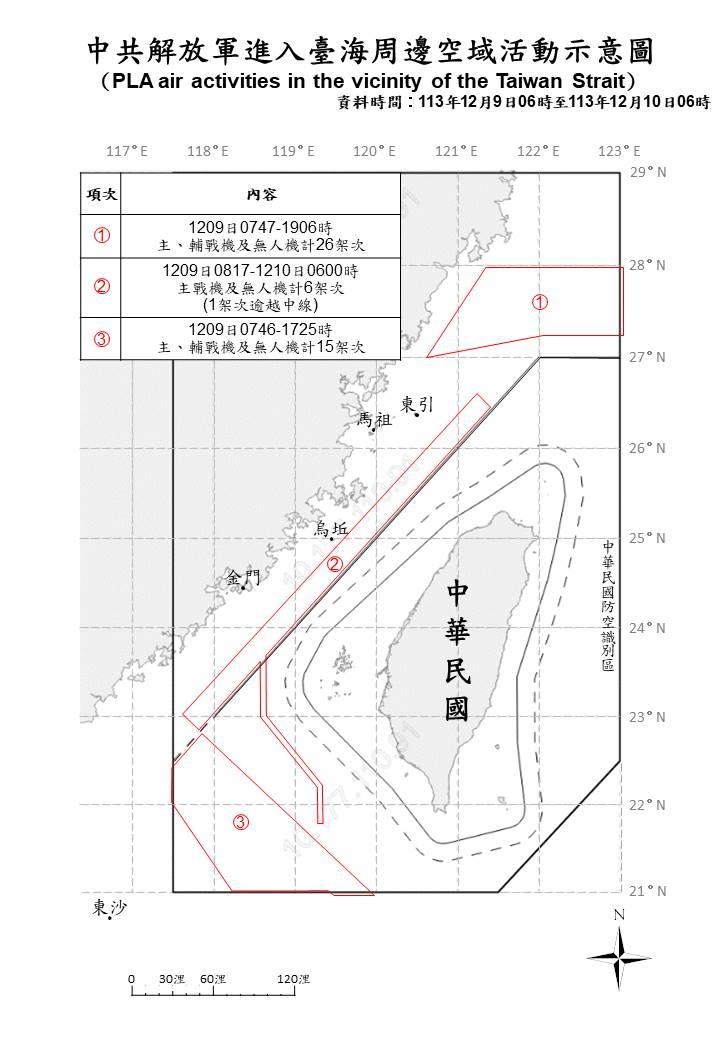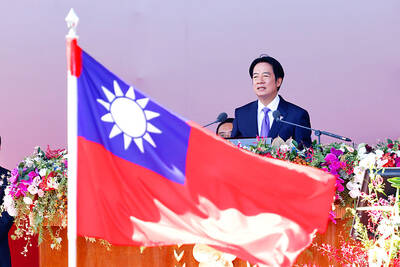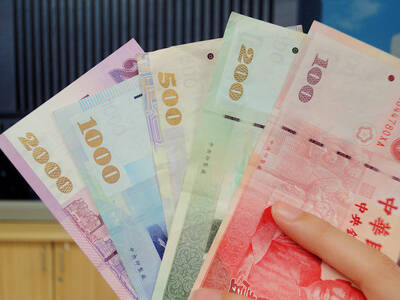China is deploying its largest navy fleet in regional waters in nearly three decades, posing a threat to Taiwan that is more pronounced than previous Chinese war games, the Ministry of National Defense said today.
Speaking in Taipei, ministry spokesperson Sun Li-fang (孫立方) said the scale of the current Chinese naval deployment in an area running from the southern Japanese islands down into the South China Sea was the largest since China held war games around Taiwan ahead of 1996 Taiwanese presidential elections.
China's military has yet to comment and has not confirmed it is carrying out any exercises.

Photo provided by the Ministry of National Defense
"The current scale is the largest compared to the previous four [exercises around Taiwan]," Sun said. "Regardless of whether they have announced drills, they are posing a great threat to us."
Senior ministry intelligence officer Hsieh Jih-sheng (謝日升) told the same news conference there have so far been no live-fire drills in China's seven "reserved" airspace zones, two of which are in the Taiwan Strait, but there had been a significant increase in Chinese activity to the north of Taiwan over the past day.
The number of China navy and coast guard ships in the region, which a Taiwan security source told Reuters remained at around 90, was "very alarming," and China was taking aim at other countries in the region and not only Taiwan, he added.
China's deployment in the First Island Chain — which runs from Japan through Taiwan, the Philippines and on to Borneo, enclosing China's coastal seas — is aimed at area denial to prevent foreign forces from interfering, Hsieh said.
The ministry said China's navy is building two "walls" in the Pacific, one at the eastern end of Taiwan's air defense identification zone and the other further out in the Pacific.
"They are sending a very simple message with these two walls: trying to make the Taiwan Strait an internal sea" of China, Hsieh said.
Earlier today, the ministry said it detected 47 military aircraft operating around the nation over the past 24 hours, as well as 12 navy vessels and nine "official" ships, which refers to vessels from ostensibly civilian agencies such as the coast guard.
Of the aircraft, 26 flew in an area to the north of Taiwan off the coast of China's Zhejiang Province, six in the Taiwan Strait and a further 15 to the nation's southwest, according to a map the ministry provided in its daily morning statement on Chinese activities.
A senior Taiwan security source told Reuters that the Chinese aircraft simulated attacks on foreign naval ships and practiced driving away military and civilian aircraft as part of a "blockade exercise."
China has held two rounds of major war games around Taiwan so far this year.
If China holds another military exercise, it would be viewed as coercive behavior which would be counterproductive in terms of diplomacy, Heino Klinck, former deputy assistant secretary of defense for East Asia, told CNA today.
The Chinese People’s Liberation Army (PLA) is extending its scale and coverage of military drills every time, which is a way of numbing Taiwan and its allies, he said.
“Normalizing” its military exercises would arouse less attention and could affect Taiwan and its allies’ judgement and shorten their reaction time if an actual invasion happens, he said.
The US is closely monitoring the PLA’s activities around Taiwan, a spokesperson of the US Department of State said today.
The department called for restraint and said China should avoid taking any actions that could destroy regional peace and stability in the Taiwan Strait.
President William Lai’s (賴清德) transit in US territory during his tour of Pacific allies last week should not be an excuse for exerting military pressure on Taiwan, it said.
China is angry because of Lai’s stopovers in Hawaii and Guam during his Pacific tour, former US Navy rear admiral Mark Montgomery said.
Montgomery, senior director of the Center on Cyber and Technology Innovation of the Washington-based think tank the Foundation for Defense of Democracies, said the PLA was expected to hold military exercises this winter.
It is worrying that the PLA’s drills have become larger and more complicated and directly threaten Taiwan’s security, he said.
These drills are intended to convey strategic messages to the Taiwanese and create opportunities for training the PLA, he said while calling on the US and Taiwan to continue to promote their bilateral relationship in suitable ways.

People can preregister to receive their NT$10,000 (US$325) cash distributed from the central government on Nov. 5 after President William Lai (賴清德) yesterday signed the Special Budget for Strengthening Economic, Social and National Security Resilience, the Executive Yuan told a news conference last night. The special budget, passed by the Legislative Yuan on Friday last week with a cash handout budget of NT$236 billion, was officially submitted to the Executive Yuan and the Presidential Office yesterday afternoon. People can register through the official Web site at https://10000.gov.tw to have the funds deposited into their bank accounts, withdraw the funds at automated teller

PEACE AND STABILITY: Maintaining the cross-strait ‘status quo’ has long been the government’s position, the Ministry of Foreign Affairs said Taiwan is committed to maintaining the cross-strait “status quo” and seeks no escalation of tensions, the Ministry of Foreign Affairs (MOFA) said yesterday, rebutting a Time magazine opinion piece that described President William Lai (賴清德) as a “reckless leader.” The article, titled “The US Must Beware of Taiwan’s Reckless Leader,” was written by Lyle Goldstein, director of the Asia Program at the Washington-based Defense Priorities think tank. Goldstein wrote that Taiwan is “the world’s most dangerous flashpoint” amid ongoing conflicts in the Middle East and Russia’s invasion of Ukraine. He said that the situation in the Taiwan Strait has become less stable

FRESH LOOK: A committee would gather expert and public input on the themes and visual motifs that would appear on the notes, the central bank governor said The central bank has launched a comprehensive redesign of New Taiwan dollar banknotes to enhance anti-counterfeiting measures, improve accessibility and align the bills with global sustainability standards, Governor Yang Chin-long (楊金龍) told a meeting of the legislature’s Finance Committee yesterday. The overhaul would affect all five denominations — NT$100, NT$200, NT$500, NT$1,000 and NT$2,000 notes — but not coins, Yang said. It would be the first major update to the banknotes in 24 years, as the current series, introduced in 2001, has remained in circulation amid rapid advances in printing technology and security standards. “Updating the notes is essential to safeguard the integrity

REASSURANCE: The US said Taiwan’s interests would not be harmed during the talk and that it remains steadfast in its support for the nation, the foreign minister said US President Donald Trump on Friday said he would bring up Taiwan with Chinese President Xi Jinping (習近平) during a meeting on the sidelines of the APEC Summit in South Korea this week. “I will be talking about Taiwan [with Xi],” Trump told reporters before he departed for his trip to Asia, adding that he had “a lot of respect for Taiwan.” “We have a lot to talk about with President Xi, and he has a lot to talk about with us. I think we’ll have a good meeting,” Trump said. Taiwan has long been a contentious issue between the US and China.